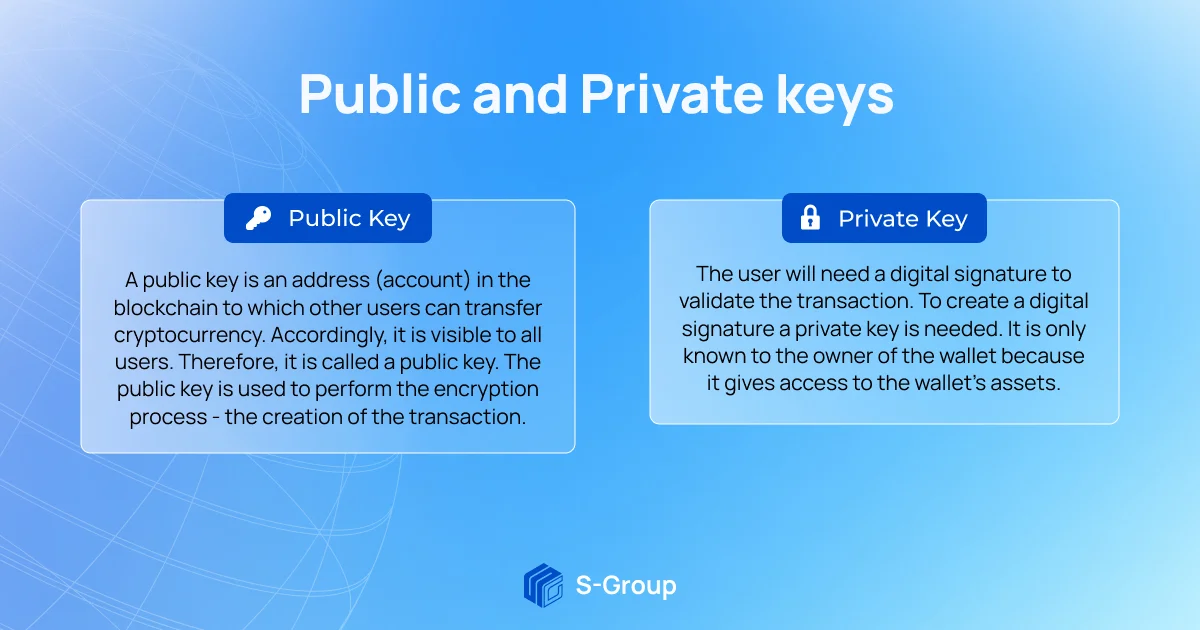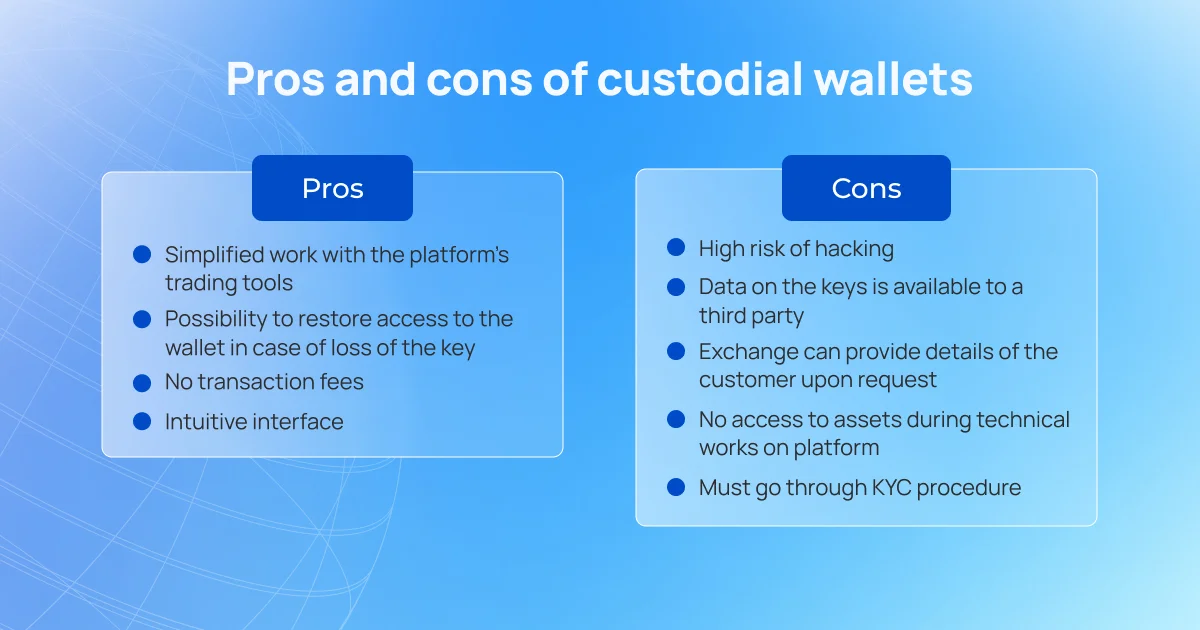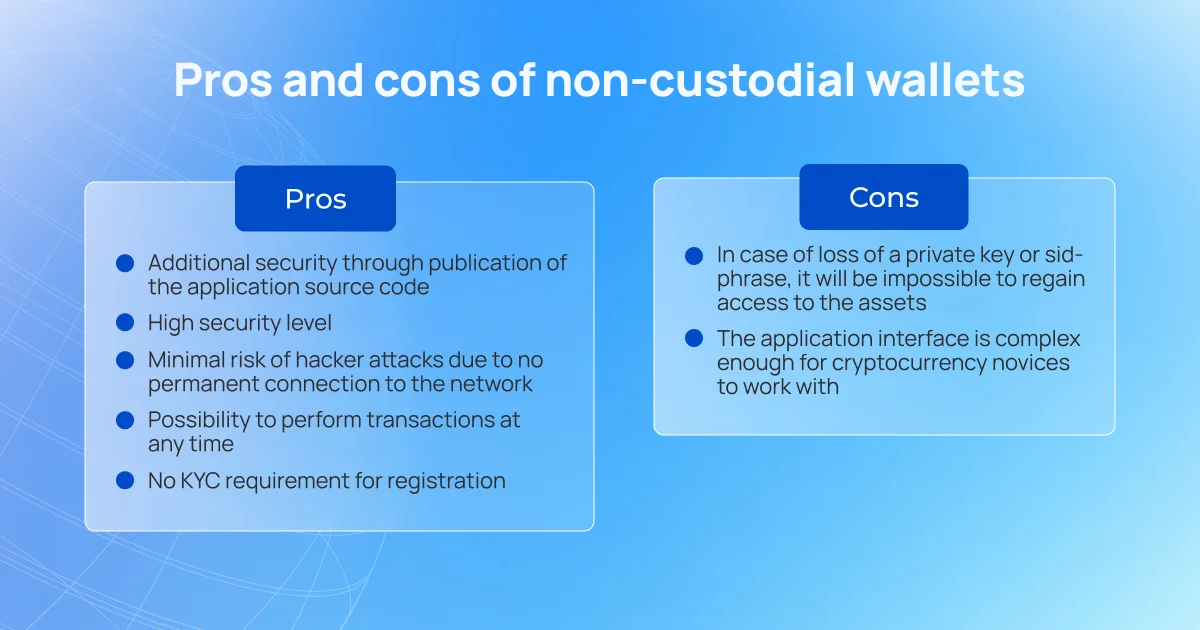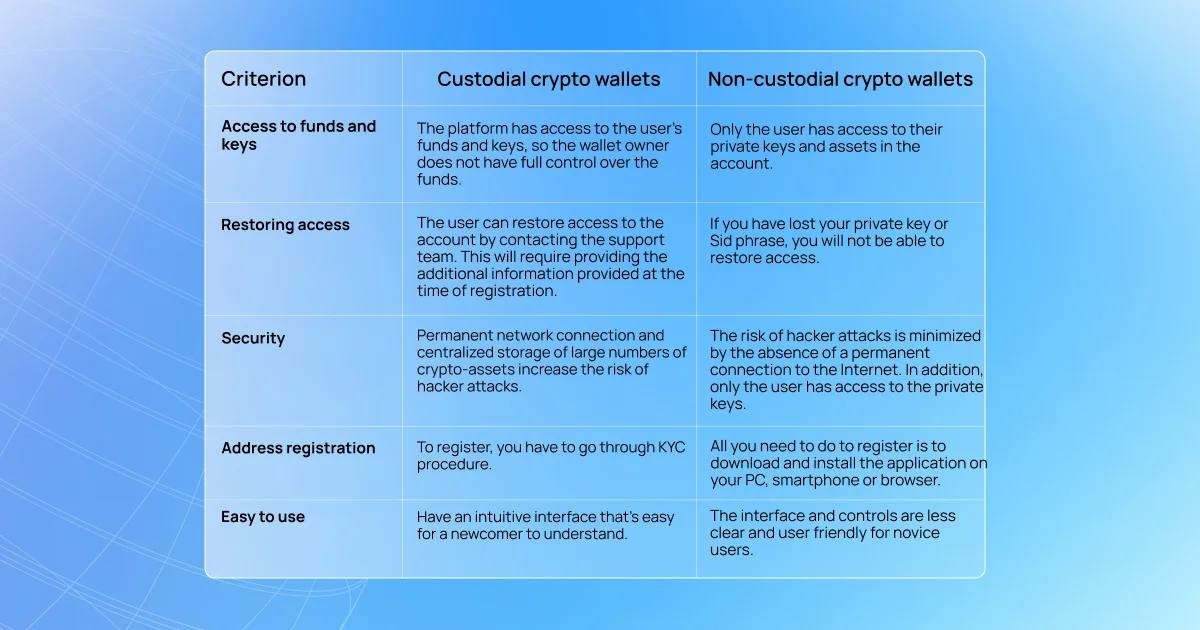Custodial and non-custodial crypto-purses: key differences

If you've ever used or even heard of cryptocurrency, you know that cryptocurrency wallets are used to store it. Crypto-wallets can be used to make transactions with assets, trade on exchanges, and access decentralized applications.
There are many different types of cryptocurrency wallets. Globally, they can be divided into two broad categories: custodial and non-custodial.
Today, let's talk about what custodial and non-custodial cryptocurrency wallets are and how they differ from each other. But first, a word or two about what cryptocurrency wallets are and how they work.
Cryptocurrency wallet: what it is and how it works
A cryptocurrency wallet is a tool for interacting with blockchain and crypto-assets. With a cryptocurrency wallet, you can create and manage addresses to store and transfer cryptocurrencies. In fact, it is an application that enables users to manage the address and the assets stored in the wallet.
All cryptocurrency wallets consist of two basic elements, a public key and a private key, which are linked and tied to a specific address.

The public key is an address (account) in the blockchain, to which other users can transfer the cryptocurrency. Accordingly, it is visible to all users. Therefore, it is called a public key. The public key is used to perform the encryption process — the creation of the transaction.
To validate the created transaction, the user needs a digital signature. To create a digital signature, a private key is needed. It is only known to the owner of the wallet because it gives them access to their assets.
The private key is very important because without it, the wallet owner will not be able to send cryptocurrency to other wallets and use it. Therefore, you should keep your private key in as safe a place as possible. For example, on a device that is not connected to the internet or on a piece of paper.
Many novice investors think that any cryptocurrency wallet is a priori safe. But it is not. It is important to understand the differences between custodial and non-custodial wallets, both in terms of functionality and security.
Custodial crypto-wallets: what they are and how they work
A custodial wallet is a wallet for storing and transferring cryptocurrency that is managed by a third party custodian (operator). That is, not only the owner of the wallet has access to the private and public keys, but also the custodian. Therefore, the wallet owner does not have full control over their assets and does not sign transactions.
But, there is an upside to this. If you create and manage the keys yourself, on the one hand, you have full control over the assets, but on the other hand, if you lose the keys, you cannot restore access to the assets, and they will be lost forever. Even if you forget your wallet password, you can restore it by contacting support.
Every centralised exchange has custodial wallets. They attract users with a simple interface and operation that even a novice can understand. To create a blockchain address with a custodial cryptocurrency wallet, users need to undergo a KYC (Know Your Customer) identity verification process. It involves confirming one's identity by providing document photos and selfies with documents.
Pros and cons of custodial wallets

Pros:
1. If you lose or forget your key/password, you can always regain access to the assets in the wallet.
2. Since custodial wallets are usually part of centralized exchanges, this makes it easier to deal with trading instruments and does not have to pay intra-network transaction fees.
3. A great option for beginners to use, as they have an intuitive interface.
Cons:
1. Centralised storage of large amounts of assets often makes exchanges a target for hacking attacks, which can leave you without your funds.
2. A third party, the exchange, has the key data.
3. Centralised crypto exchanges are subject to legislation and law enforcement requirements. Therefore, if there is a request to provide customer data or freeze funds — the exchange has to comply with it.
4. No access to assets during technical works of the platform.
5. If an exchange is shut down by court order or by the authorities, you will never be able to recover your assets.
6. You have to go through KYC, which takes time because the platform will have to verify the identity of the user.
In 2017, for example, the BTC-e crypto-exchange's servers were seized. Although the platform was relaunched under the new name WEX, customers never regained access to their funds. Hackers withdrew 120,000 bitcoins from the Bitfinex exchange in 2016. Multi-signature and two-factor authentication were not an obstacle for attackers.
Bottom line: Experienced crypto investors are advised to keep small amounts of assets in custodial wallets. Custodial wallets are a great option for those new to cryptocurrency who are just getting familiar with the field.
Non-custodial wallets: what they are and how they work
A non-custodial wallet is a decentralised application that retains full control over its owner's funds and does not share their private keys with any third party. Such wallets cannot freeze users' accounts and deny them access to their account. Only the owner has access, but the responsibility for the security and storage of the private keys also rests solely with the owner.
Non-custodial crypto-wallet— great option for experienced crypto-investors, who know how to use and keep safe their keys and sid-phrases (phrases from 12 or 24 words to log in to the wallet in case of losing access to it).
Such wallets are used for cryptocurrency trading, as well as for interaction with decentralised applications and exchanges such as Uniswap, PancakeSwap, SushiSwap, QuickSwap. They are downloaded to a PC or installed on a smartphone or as an extension in a browser. For example, the non-custodial cryptocurrency wallet MetaMask can be installed on a smartphone or downloaded as a browser extension.
Users do not need to go through KYC procedures to create a blockchain address using a non-castodial cryptocurrency wallet.
Pros and cons of non-custodial cryptocurrencies

Pros:
1. High level of security as private key data is only stored by the wallet owner.
2. Additional security due to the publication of the application's source code. This makes it possible to make sure that the wallet is safe to use as well as store the cryptocurrency. In addition, non-custodial wallet projects are often supported by communities of programmers.
3. Users are able to make transactions at any time.
4. Non-custodial wallets do not have a constant connection to the network, which minimises the risk of hacking attacks.
5. There is no KYC process to register an address, which makes the registration process much simpler.
Cons:
1. If the private key or sido is lost, it will not be possible to regain access to the assets. It is estimated that about $140 billion worth of assets have been blocked globally due to lost keys.
2. The application interface is complex enough for cryptocurrency novices to work with.
Bottom line: non-custodial wallets are great for experienced investors to use for storing large amounts of cryptocurrencies. If you choose this type of wallet, remember that the responsibility for asset security and key storage, as well as the sid-phrase, lies entirely with you.
Comparing custodial and non-custodial cryptocurrency wallets
We will be comparing custodial and non-custodial cryptocurrencies based on five main criteria: access to funds, recovery of access to funds, security, address registration, usability.

How to secure your cryptocurrency wallet and assets
Regardless of whether you choose a custodial or non-custodial wallet, you should follow basic security measures. We've prepared a list of rules for you to remember in order not to fall victim to scammers and lose your assets.
1. Keep the sid-phrase in a safe place. Never give it to a third party, write it down on paper and don't make a digital copy of it. It is not advisable to make a screenshot of the sid-phrase, or send it to yourself in an email/messenger, etc.
2. Do not click on dubious links. Often, fraudsters gain access to user accounts by creating a copy of a popular crypto platform's website. When clicking on any link, even if it seems familiar to you, check its address carefully or save the site to bookmarks, so your data won't be stolen by fraudsters.
3. Don't share sensitive information with third parties. Very often, scammers create identical platform support accounts and ask users for confidential information. Remember that platform administrators never ask for such information.
4. Enable two-factor authentication. If using a custodial crypto wallet, activate two-factor authentication, verify by phone number and mail to increase the level of security.
Which cryptocurrency wallet should I choose: custodial or non-custodial?
The best option is to identify your crypto-assets goals and split them into two wallets. In the custodial one, store a small amount of coins that you will use for quick cryptocurrency transactions. Use the non-custodial wallet for storing large amounts of assets, as it has a higher level of security.
If you are just getting started with cryptocurrency, a custodial crypto-wallet with a clear interface, ability to access your account and help from tech support is the right choice.
One last piece of advice — always be aware of security and take precautions.
Share
Interesting
Would you like to receive a digest of articles?
One email with the best articles of the week.
Sign up so you don't miss anything.